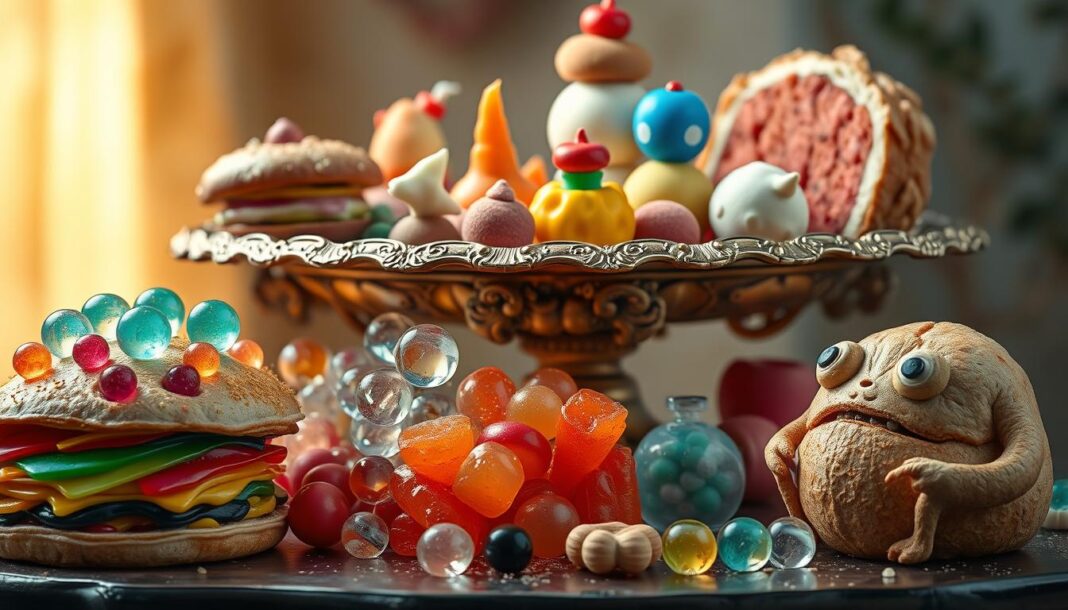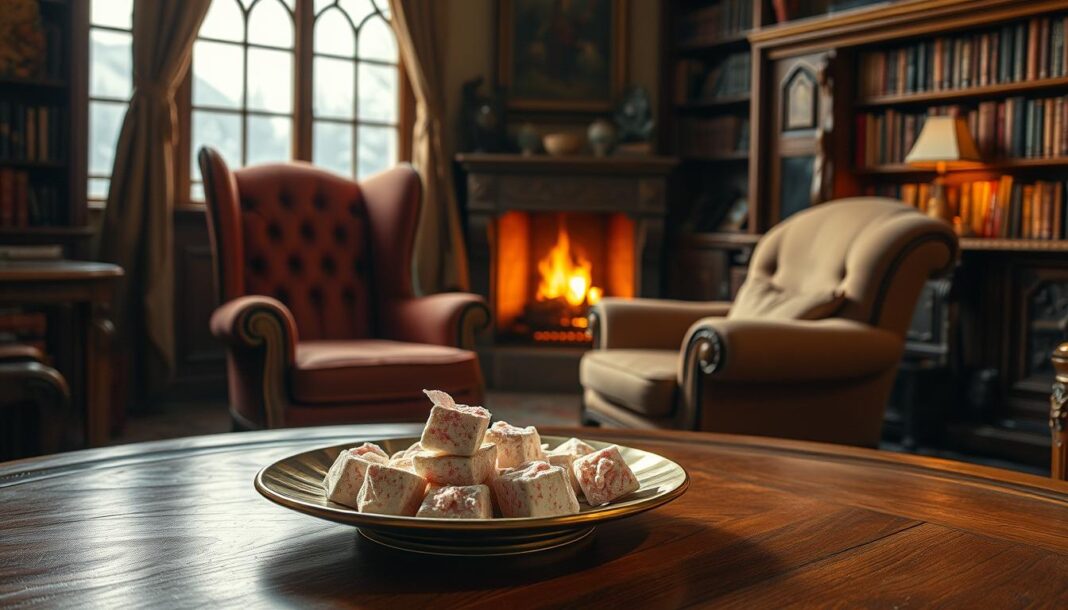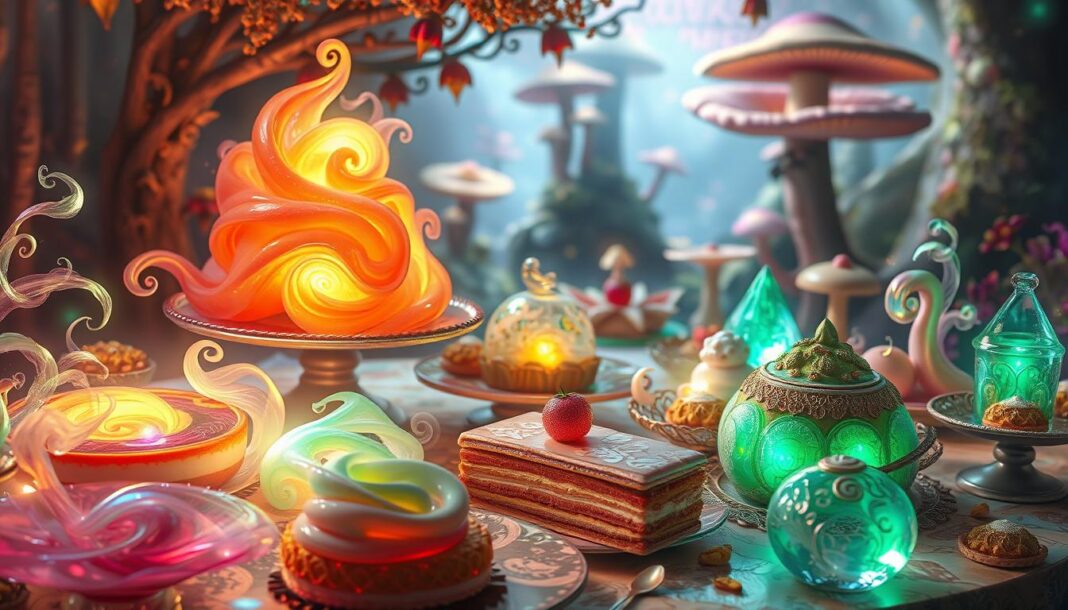Food and cinema are two of life’s greatest pleasures, and they naturally pair well together. Movies can make food look far tastier and more mind-blowing than it ever could in real life.
The best of these fictional foods don’t just look yummy; they stretch the imagination, move the story along, serve as a vital piece of world-building, or are simply intriguing and inventive.
We explore the fascinating world of fictional cuisine that has captured the imagination of audiences across various media. Our comprehensive guide delves into the most iconic made up foods from various fictional universes, examining their cultural impact and why they’ve become cultural touchstones.
Key Takeaways
- Fictional foods serve as powerful storytelling devices, revealing aspects of character development and world-building.
- Certain fictional foods resonate deeply with audiences, sometimes inspiring real-world recreations.
- We’ll categorize and examine memorable fictional foods that have made us wish they existed in reality.
- Some fictional foods have crossed over into the real world, becoming actual products for fans.
- The cultural impact of these imaginary culinary creations continues to fascinate us.
The Fascination with Fictional Foods
Fictional foods have a way of captivating our imagination, making us crave a reality that’s more vibrant and delicious. Cartoons and movies often feature fictional foods that are not only mouth-watering but also spark our imagination and desire.
We’ve observed several factors contributing to this fascination:
- Fictional foods often appear more vibrant and appetizing than their real-world counterparts.
- The visual presentation in animation and film makes these dishes look impossibly perfect.
- Online communities have formed around the desire to taste these fictional creations.
The table below summarizes the key aspects of our fascination with fictional foods:
| Aspect | Description | Impact |
|---|---|---|
| Visual Presentation | Exaggerated techniques make food look perfect | Increases desire |
| Community Engagement | Online forums and social media groups discuss fictional foods | Creates a shared cultural experience |
| Inaccessibility | Fictional foods are unattainable | Enhances appeal |
Why Made Up Foods Capture Our Imagination
The allure of made up foods lies in their ability to tantalize our taste buds and spark our imagination. We’ve identified several factors that contribute to their appeal.
One key aspect is the way these foods are presented – often looking irresistibly scrumptious and sparking our curiosity to try them in real life. The reactions of cartoon characters to these foods also play a significant role, heightening our desire to experience them.
Our analysis reveals that made up foods often represent idealized versions of familiar dishes, amplifying the pleasure associated with eating. They also embody cultural values and aspirations, serving as metaphors for abundance or creativity.
- Made up foods frequently possess impossible properties, such as eternal flavor or perfect texture, appealing to our desire to transcend the limitations of ordinary life.
- These culinary creations often represent a form of escapism, offering a reprieve from mundane eating experiences.
- Nostalgia plays a significant role in our attachment to fictional foods, intertwining them with cherished memories.
| Aspect | Description | Impact |
|---|---|---|
| Presentation | Irresistibly scrumptious visuals | Sparks curiosity |
| Cultural Significance | Embodiment of cultural values | Serves as metaphors for abundance or creativity |
| Impossible Properties | Eternal flavor, perfect texture | Appeals to desire for transcendence |
By examining these factors, we can understand why made up foods continue to captivate our imagination over time.
The Wizarding World’s Magical Treats
The Wizarding World’s culinary creations are a testament to the imaginative depth of the Harry Potter series. The magical treats in this universe are not just delightful; they also play a significant role in enhancing the world-building. Chocolate Frogs, for instance, combine the familiar with the magical, as they jump and move like real frogs.
Other iconic treats include Bertie Bott’s Every Flavor Beans and Butterbeer, which have become cultural phenomena. These magical confections serve as important plot devices and have inspired real-world products.
Willy Wonka’s Extraordinary Confections
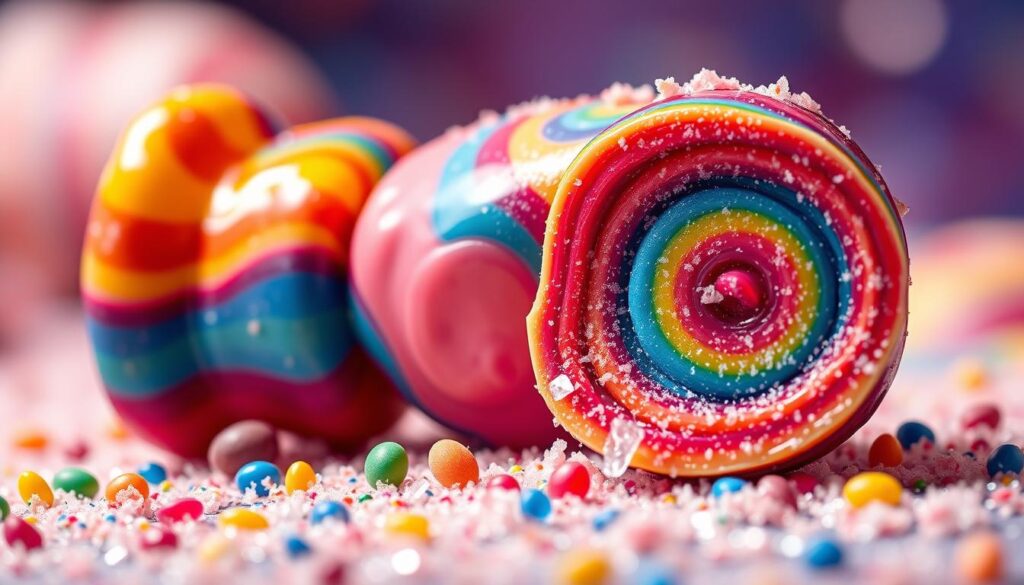
Roald Dahl’s Willy Wonka has become synonymous with extraordinary candies that defy the ordinary. We examine Roald Dahl’s imaginative confectionery creations brought to life in Willy Wonka’s chocolate factory, analyzing how they represent both childlike wonder and subtle social commentary. The Everlasting Gobstopper, a candy that never diminishes, was invented “for children with very little pocket money,” addressing economic inequality.
Wonka’s creations, from the Wonka Bar to the Lickable Wallpaper for Nursery Walls, blur the line between food and experience, transforming eating into an adventure. These confections embody the perfect balance between nostalgia and innovation, explaining their enduring appeal across generations. We investigate how these fictional sweets have influenced real-world candy manufacturing and marketing.
Cartoon Cuisine: From Krabby Patties to Pretty Patties
Cartoon cuisine has become an integral part of pop culture, with dishes like Krabby Patties captivating audiences worldwide. The iconic burger from SpongeBob SquarePants is a prime example, with its secret formula driving the show’s central conflict.
We examine the visual evolution of cartoon food representation, from simple to elaborate designs, with Pretty Patties serving as a perfect example of food as artistic expression. Other memorable cartoon foods and dishes have achieved cult status, often emphasizing visual appeal over culinary realism.
| Cartoon Dish | Show/Series | Cultural Impact |
|---|---|---|
| Krabby Patty | SpongeBob SquarePants | Inspired real-world products and promotions |
| Scooby Snacks | Scooby-Doo | Become a cultural reference for snacks |
| Good Burger Special Sauce | Good Burger | Influenced fast food marketing strategies |
Sci-Fi Sustenance: Futuristic Fictional Foods
In the realm of science fiction, food becomes a lens through which we examine the intersection of technology and society. We see this in films like “Back to the Future II,” where a dehydrated pizza represents the convenience foods of the future.
Science fiction uses futuristic food to explore potential technological advancements and their impact on life. For instance, “Soylent Green” depicts a dystopian future where the population relies on processed rations, raising questions about the ethics of food production and its effect on mankind.
| Film | Futuristic Food Concept | Commentary |
|---|---|---|
| Back to the Future II | Dehydrated Pizza | Convenience and rapid preparation |
| Soylent Green | Processed Food Rations (Soylent) | Dystopian future, ethical compromises |
As we look to the future, these narratives encourage us to think about the time we’re living in and how our food choices reflect our values. By examining these futuristic foods, we gain insights into potential societal changes and technological advancements.
Middle-Earth’s Mythical Provisions
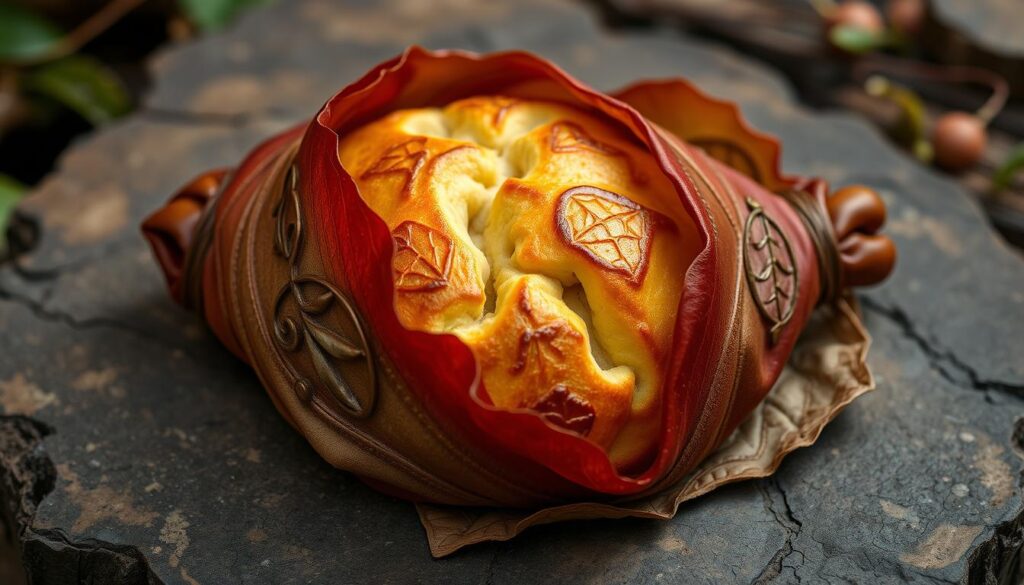
The fictional world of Middle-Earth is replete with mythical provisions that not only sustain the characters but also enrich the story. At the heart of these provisions is lembas bread, the Elvish waybread known for its nutritional value and long shelf life, making it ideal for long journeys.
Designed to be highly nutritious, lembas bread stays fresh for months when wrapped in mallorn leaves, playing a crucial role in Frodo’s and Sam’s perilous journey into Mordor. As depicted in The Lord of the Rings, such foods are not just a meal but a symbol of hospitality and community, reflecting the cultures and values of Middle-Earth’s diverse races.
For more insights on how food is used in storytelling within The Lord of the Rings, visit Food and Storytelling in The Lord of the. This enriches our understanding of how these mythical provisions contribute to the narrative and life of the characters in the epic saga of The Lord of the Rings.
Cinematic Burgers: Big Kahuna and Beyond
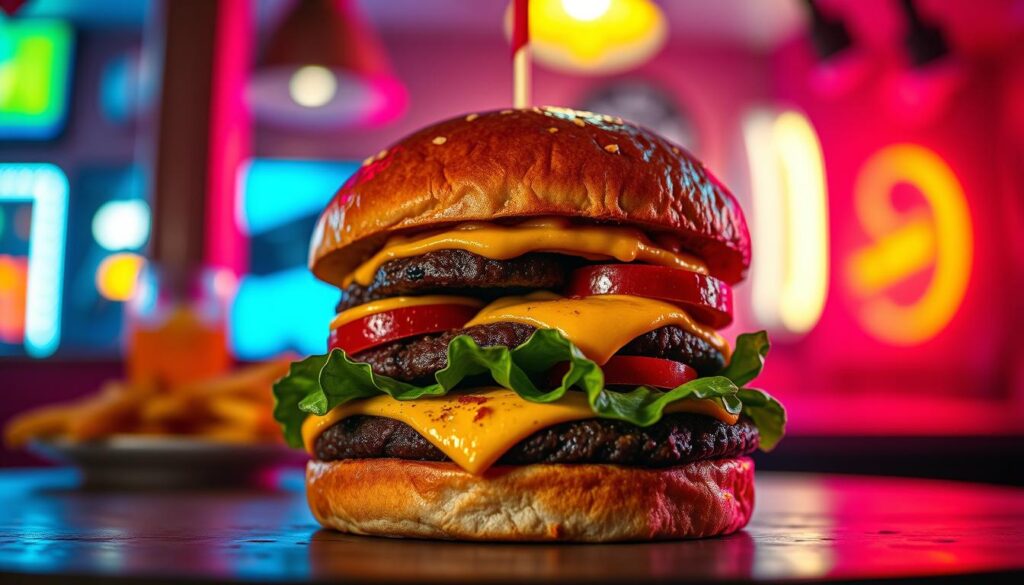
Pulp Fiction’s Big Kahuna Burger is more than just a meal; it’s a cultural touchstone that continues to influence our perception of food in movies. The Big Kahuna Burger first appeared in Reservoir Dogs but gained notoriety in Pulp Fiction as the last meal of the characters executed by Vincent Vega and Jules Winnfield. Jules taunts them, declaring, “Hamburgers – the cornerstone of any nutritious breakfast!” This scene has become iconic in cinema history.
The burger has since been referenced in multiple Tarantino films and other movies, symbolizing Americana and cultural identity. Directors use food scenes to establish character traits and relationships, with Big Kahuna being a prime example.
Animated Feasts That Made Us Hungry
From ‘Be Our Guest’ in Beauty and the Beast to Remy’s ratatouille in Ratatouille, animated films have perfected the art of making food a central element of storytelling. These cinematic feasts not only tantalize our taste buds but also often serve as pivotal moments in the narrative, showcasing cultural heritage and culinary artistry.
Animated movies have a unique ability to make food look irresistibly appetizing, often surpassing live-action films in their idealized culinary experiences. The “Be Our Guest” sequence from Beauty and the Beast is a prime example, combining visual splendor with a musical celebration of food that has become iconic in Disney history. The feast features various French dishes presented in an elaborate dinner sequence where enchanted household objects perform for Belle.
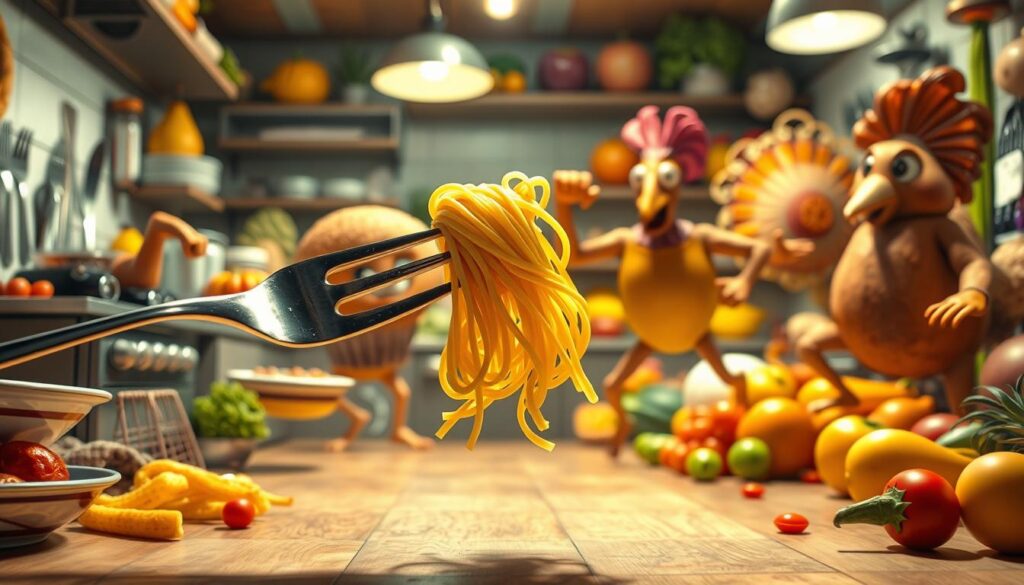
The technical artistry behind animated food is noteworthy, with details such as the steam rising from a bowl of ramen in Ponyo or the textural perfection of Remy’s ratatouille in Ratatouille. These elements not only showcase the animators’ skill but also contribute to the narrative, often triggering emotional responses or memories in both the characters and the audience.
Let’s examine some notable examples of animated feasts and their impact:
| Movie | Dish | Cultural Significance |
|---|---|---|
| Beauty and the Beast | French Feast | Showcases French culinary tradition and hospitality |
| Ratatouille | Ratatouille | Represents the beauty of simple, high-quality ingredients and French cuisine |
| The Princess and the Frog | Gumbo | Highlights New Orleans cuisine and Tiana’s culinary passion |
These animated meals have not only captivated audiences but have also inspired real-world chefs and home cooks to recreate these dishes. The cross-cultural representation of food in animation enriches our understanding and appreciation of different culinary traditions, making the viewing experience more engaging and memorable.
In conclusion, the art of depicting food in animated movies is a significant aspect of their appeal, combining culinary artistry with storytelling and cultural representation. As we continue to be fascinated by these cinematic feasts, it’s clear that their impact extends beyond the screen, influencing how we think about and engage with food in our own lives.
Peculiar Potions and Magical Elixirs
The allure of magical drinks, from Harry Potter’s potions to Willy Wonka’s Fizzy Lifting Drinks, is undeniable in popular culture. These fantastical beverages not only captivate our imagination but also serve as pivotal elements in their respective narratives.
We observe that magical elixirs like Felix Felicis from the Harry Potter universe and Gummiberry Juice from the Adventures of the Gummi Bears grant extraordinary abilities, ranging from luck to superhuman strength. These potions often externalize internal qualities or provide temporary escapes from the characters’ limitations.
Let’s examine the characteristics and effects of these magical drinks:
| Beverage | Source | Effect |
|---|---|---|
| Felix Felicis | Harry Potter | Liquid Luck |
| Fizzy Lifting Drinks | Charlie and the Chocolate Factory | Floating Ability |
| Gummiberry Juice | Adventures of the Gummi Bears | Super Strength and Bouncing Ability |
These magical elixirs have inspired real-world creations, from themed cocktails to specialty sodas. The influence of fictional beverages on our culinary culture is undeniable, reflecting our enduring fascination with the magical and extraordinary.
Dangerous and Dubious Made Up Foods
Fictional cuisine often takes a dark turn, revealing the dangers of unchecked scientific progress and corporate greed. We examine the darker side of fictional foods, including “Tomacco” from The Simpsons, a genetically modified tomato-tobacco hybrid that serves as satire on the tobacco industry and agricultural biotechnology.
| Fictional Food | Origin | Warning |
|---|---|---|
| Tomacco | The Simpsons | Genetic modification risks |
| Soylent Green | Soylent Green (film) | Resource depletion |
| Three-Course Dinner Gum | Willy Wonka | Unexpected side effects |
These foods serve as cautionary tales As we explore these dubious foods, we see how they influence real-world conversations about food safety and sustainable production.
Fictional Foods That Became Real
From screen to shelf, fictional foods are becoming a reality. The Willy Wonka chocolate factory’s influence is evident in stores with Wonka chocolate products, including the beloved Everlasting Gobstoppers.
Fans can now enjoy real-life versions of fictional treats, such as Cheesy Poofs inspired by South Park and Stay Puft marshmallows from Ghostbusters. Universal Studios’ Wizarding World of Harry Potter has also brought fictional foods to life with immersive experiences like Butterbeer.
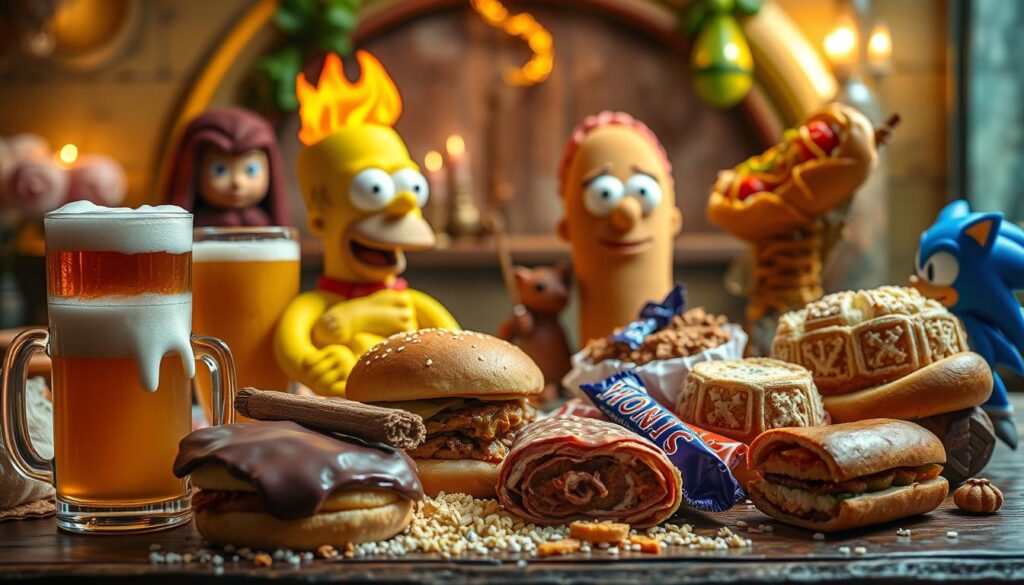
These examples demonstrate how fictional foods can transition into real life, driven by fans and innovative commercial strategies.
DIY Fictional Food Recipes
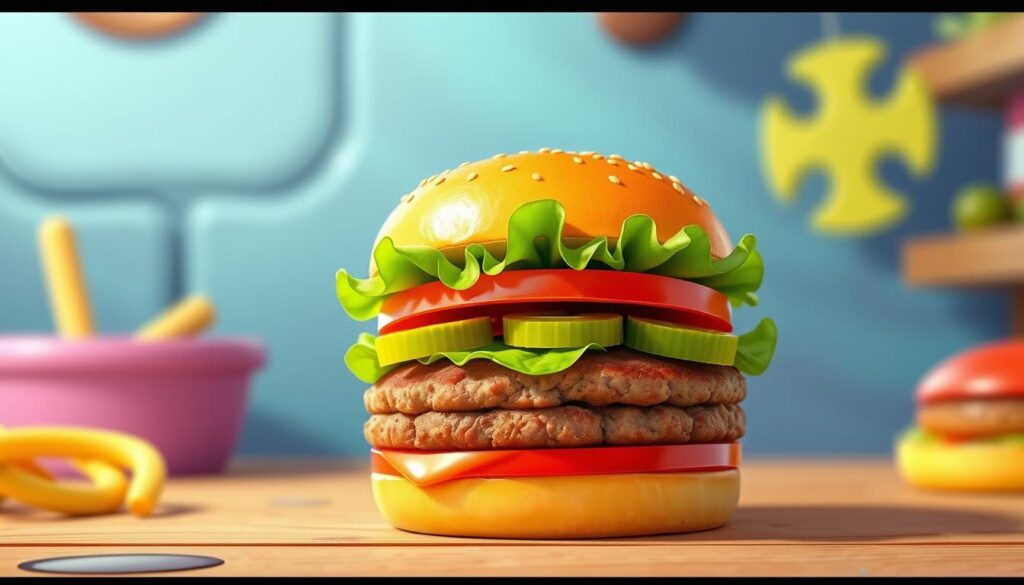
Fictional foods have stepped out of their screens and into our kitchens, inspiring a new wave of culinary creativity. Home cooks and chefs are recreating beloved dishes like Krabby Patties, using burger patties or crab cakes as the base. Social media platforms have become hubs for sharing these recipe recreations, often turning them into viral content.
These DIY projects not only bring fictional cuisine to life but also introduce cooks to new techniques and ingredients, sometimes improving upon the original concept. Whether it’s a chocolate treat or a homemade pizza, the art of recreating fictional foods is a fun and educational culinary adventure.
The Cultural Impact of Made Up Foods
Made up foods have become an integral part of pop culture, transcending their origins in movies and other media. These fictional culinary creations not only captivate fans but also influence the way we think about and interact with food in the real world.
We examine how these foods have become cultural touchstones, symbolizing the fictional worlds from which they come. For instance, Butterbeer from the Wizarding World of Harry Potter or the iconic Krabby Patty from SpongeBob SquarePants evoke immediate recognition and nostalgia in fans.
The economic impact of these fictional foods is significant, with theme park attractions, merchandise, and licensed products generating substantial revenue. Moreover, they create shared cultural references that span generations, as parents introduce their children to the fictional foods they grew up with.
Our analysis reveals that made up foods have also influenced real-world culinary trends. Chefs and food manufacturers draw inspiration from these imaginary creations, incorporating elements into their own recipes and products. This phenomenon demonstrates the profound influence of movie and pop culture on our culinary landscape.
The Psychology Behind Our Longing for Fictional Foods
Our fascination with made-up foods stems from their ability to transcend the limitations of real cuisine. The impossible properties of many fictional foods, such as eternal flavor and perfect texture, appeal to our innate desire for something extraordinary.
These culinary creations often represent a form of escapism, offering a momentary reprieve from the mundane aspects of everyday eating. The nostalgia factor plays a significant role in our attachment to fictional foods, as they become intertwined with cherished memories of the stories in which they appeared, much like a favorite candy from a beloved childhood tale.
| Psychological Aspect | Description | Example |
|---|---|---|
| Escapism | Fictional foods offer a break from everyday eating. | Willy Wonka’s Chocolate River |
| Nostalgia | Fictional foods evoke memories of cherished stories. | Krabby Patties from SpongeBob SquarePants |
| Idealization | Fictional foods represent perfect versions of real dishes. | Perfect burgers from cinematic universes |
As we explore the psychological mechanisms behind our longing for fictional foods, we find that they tap into fundamental human desires, such as the desire to transcend ordinary limitations. This is evident in the way fictional foods are often presented in a visually appealing manner, triggering physiological responses despite being unattainable. The shared longing for these foods creates a sense of community among fans, serving as a form of cultural currency. At some point in time, these foods become a part of our collective memory, associated with memorable characters and stories that captivate a man‘s imagination in a unique way.
Nostalgia plays a significant role in our attachment to these foods, making them even more appealing.
Why Fictional Cuisine Continues to Inspire Us
The allure of made-up foods continues to captivate audiences worldwide, transcending generations and media formats. Fictional cuisine represents the perfect intersection of storytelling, visual art, and sensory experience, creating powerful multi-dimensional memories. These culinary creations often embody the themes and values of their stories—from the communal bread of Middle-Earth to the whimsical treats of Willy Wonka.
By inspiring real creativity, fictional foods influence both professional chefs and home cooks, encouraging innovation in the kitchen, much like recreating a beloved pizza or a special meal from a favorite cartoon. This phenomenon connects us to our childlike sense of wonder, reminding us that food is a cultural artifact, a social experience, and a canvas for human creativity throughout history.
